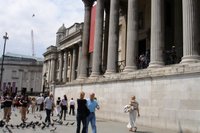The National Gallery

I recently decided that a visit to The National Gallery in
I personally prefer to wander around a gallery of my own free will but you can get a variety of audio tours (highlights or themed tours, or choose whichever commentary you wish to listen to from over 1000 paintings) or free guided tours. A voluntary donation is suggested. However, I found the labeling of the paintings quite informative as to the background of most paintings.
My first stop when I arrived was the Espresso Bar, not just because it was a hot day and I was thirsty, but to use the micro gallery. The bar contains a number of computer consoles (it doesn’t appear that you need to purchase anything to use them, the bar is not cheap – a bottle of Pepsi cost me £1.75) which you can use to search for particular painting or artists and read a background on them or find where they are located if you have a certain picture you are desperate to see. You can also print out a personal ‘tour’ featuring up to ten paintings. This is also a useful tool to keep younger visitors entertained.
There are a large number or rooms in the gallery and I believe it is essential to pick up one of the free plans as you come in, which is available in a variety of languages and mean you don’t miss out on anything. Also indicated on these plans are Gallery Highlights.
I started in the West Wing which contains works from the sixteenth century and is strongly influenced by Italian art with paintings by da Vinci, Titian, Michelangelo and Raphael. Also represented is Holbein in the German room, plus a number of Dutch rooms. Pieces of note in this part include Michelangelo’s unfinished The Entombment, Raphael’s Madonna and the Pinks, Titian’s Bacchus and Ariadne and Bronzino’s rather odd and slightly disturbing Venus, Cupid, Folly and Time.
The North Wing is devoted to seventeenth century paintings, the emphasis this time is more on Dutch and Flemish artists, with some rooms donated to Spanish, French and Italian paintings also. The art is quite varied from Cuyp’s rural scenes featuring lots of cows to Rembrandt’s self portrait to Velazquez’s Rokeby Venus. A honorable mention should also go to van Hoogstraten’s peepshow. One of the few surviving works of its type, it is a three-sided piece of art that looks odd at the front, but if you look through the holes at either end, you see a room scene as three-dimensional. This was one of my personal highlights. Also in this section are works by Turner and the paintings that influenced them by Claude Lorrain and Vermeer’s Young Woman Standing at a Virginal and its sister Young Woman Sitting at a Virginal. I may have slightly dark tastes in art, but I also liked Giordano’s Perseus turning Phineas and his followers to Stone.
The East Wing is dedicated to eighteenth and nineteenth century paintings. Here there is a lot more British art as well as some key Impressionist pieces. One of the most famous British paintings, Constable’s The Hay Wain, can be found alongside works by Turner, Gainsborough and Stubbs’ Whistlejacket (the life-size horse portrait). In the Impressionist sections there are many Monet’s from his garden and also from
I left the early paintings to last as I had seen a lot of similar painting at the Uffizi in
The National Gallery also offers lectures on key paintings and special exhibitions. Currently they are showing an exhibition entitled Rebels & Martyrs: The Image of the Artist in the Nineteenth Century. Admission to the exhibition is £8 or £4 after
The Gallery offers a waiter service café and restaurant as well as the more informal Espresso Bar and has two gift shops. Both shops sell the usual assortment of postcards (at a very reasonable 50p each) as well as notebooks, posters and other stationery gifts depicting works found in the Gallery. There are plenty of books and other gifts, with a larger selection in the ground floor shop in the Sainsbury Wing. I found the toilets to be clean and tidy and disabled access (special entrances, toilet facilities and lift access to all levels) is good. They also do special sign language tours and talks for the deaf and have descriptive audio tours and large print labels for the visually impaired. Baby changing facilities are also available. The Gallery is not specifically child friendly, as paintings are hung at adult eye level, although there currently is a children’s art exhibition which is free. There are plenty of seats if you wish to reat and/or take in a particular painting for a longer period.
Opening Hours:
Daily
Wednesday
Admission: Free except for some special exhibitions. Donations welcome (and deserved!).
All in all this is a good way to while away an afternoon in central


0 Comments:
Post a Comment
<< Home